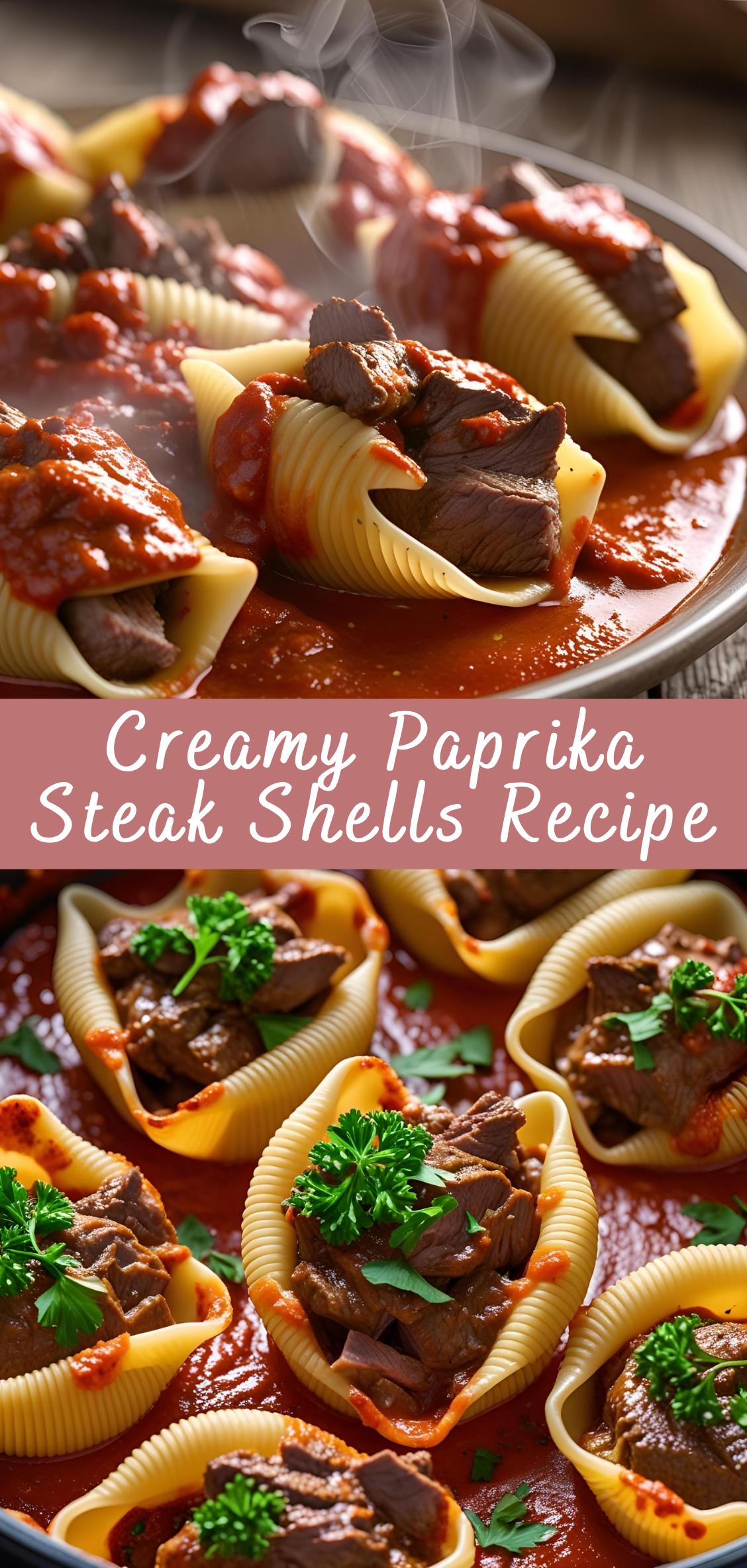Creamy Paprika Steak Shells Recipe
In the landscape of comfort food, few dishes strike the perfect balance between hearty indulgence and bold sophistication quite like Creamy Paprika Steak Shells. This dish takes its inspiration from classic European flavors—particularly the warm, smoky richness of Hungarian paprika—and fuses it with the creamy, indulgent depth of American pasta traditions. It’s a dish that feels as at home on a casual weeknight dinner table as it does at a gathering of guests hungry for something soulful and unexpected.

At its core, this recipe is about contrast and harmony. You have tender, seared steak bites—juicy, well-seasoned, and packed with umami—paired with al dente pasta shells that cradle a luxuriously creamy paprika-infused sauce. The result is a layered dish, both rustic and refined, comforting yet boldly flavored. Every bite delivers richness balanced by subtle heat and earthy spice, making it far more than just another steak-and-pasta dinner.
Why Paprika?
Paprika often plays a background role in many recipes—an afterthought sprinkled over deviled eggs or used to lightly dust roasted potatoes. But in this dish, paprika takes center stage. Not just a garnish, it’s the foundational spice that gives the sauce its unmistakable depth and color. Whether you’re using sweet Hungarian paprika, smoky Spanish pimentón, or a combination of both, the spice lends warmth without overwhelming heat and brings a complexity that sets this dish apart.
The magic of paprika lies in its versatility. Sweet paprika adds a mild fruitiness and vibrant color. Smoked paprika introduces a woodsy depth, reminiscent of open-fire cooking. Hot paprika brings a kick of heat for those who prefer bolder flavors. Used thoughtfully, it transforms the creamy sauce into something far more nuanced and layered than your average Alfredo or béchamel.
Elevating Everyday Ingredients
What’s special about Creamy Paprika Steak Shells is that it doesn’t rely on hard-to-find or pretentious ingredients to achieve its impact. The recipe calls for familiar staples: heavy cream, garlic, onion, pasta, steak, and spices. But the technique—and the balance of those ingredients—is what elevates the dish. The steak is pan-seared until perfectly browned on the outside and tender inside, then sliced or cubed for easy eating. The pasta shells are chosen not just for aesthetics but for function: their curved shape captures the sauce, delivering flavor in every bite.
This is a dish designed with care. Garlic is gently sautéed to release its sweetness, onions are caramelized just enough to deepen their flavor, and the sauce is built slowly—layered with cream, broth, and paprika until silky and clinging. A touch of Dijon mustard or Worcestershire sauce may be added for tang and complexity. Finish it with fresh parsley, a sprinkle of grated cheese, or a hint of lemon zest for balance, and you’ve got a one-pan meal that’s as well-rounded as it is indulgent.
A Dish for All Seasons
Creamy Paprika Steak Shells is one of those rare meals that transcends seasons. It’s cozy and satisfying enough for winter evenings, when rich meals offer comfort and warmth, yet lively and peppery enough to enjoy in spring or autumn with a glass of red wine and a side salad. For those who love hearty meals with depth but don’t want to spend hours in the kitchen, this recipe hits the sweet spot between simplicity and complexity.
It’s equally adaptable. Want to use sirloin, ribeye, or flank steak? Each brings its own texture and flavor. Prefer to swap steak for chicken, mushrooms, or a plant-based protein? The creamy paprika sauce welcomes substitutions. And the pasta? While shells are ideal, you could easily use penne, fusilli, or tagliatelle—whatever you have in the pantry.
Comfort Food, Reinvented
In a time when convenience and comfort dominate our kitchen priorities, it’s easy to fall into predictable routines. But dishes like Creamy Paprika Steak Shells remind us that comfort food can be both familiar and exciting. This isn’t the heavy, one-note cream sauce of fast food pasta bowls. It’s layered, thoughtful, and deeply satisfying. It’s a meal that tells a story—with every ingredient chosen for its purpose, every step building on the last.
Whether you’re cooking for two on a quiet night in or feeding a table full of hungry friends, this dish invites you to slow down, savor, and appreciate the joy of cooking with flavor in mind.
In this comprehensive guide, we’ll walk you through the full process of making Creamy Paprika Steak Shells from start to finish. We’ll explore ingredient substitutions, step-by-step cooking techniques, tips for getting the perfect sear on your steak, variations for dietary needs, and ideas for what to serve alongside. We’ll also dive into the history and culinary uses of paprika, so you can better understand this key ingredient’s cultural roots and flavor profile. By the end, you’ll not only have a recipe—you’ll have a deeper appreciation for how classic techniques and bold seasoning can transform everyday meals into memorable experiences.
So sharpen your knives, boil the water, and grab your favorite skillet. It’s time to make something truly satisfying.
Step-by-Step Instructions for Creamy Paprika Steak Shells
Step 1: Gather Your Ingredients and Tools
Before you begin cooking, it’s essential to prepare your mise en place. Having all your ingredients prepped and within reach makes the cooking process smoother and more enjoyable.
Core Ingredients:
-
12 oz (340 g) medium pasta shells (or substitute with penne, rigatoni, or fusilli)
-
1 lb (450 g) steak (sirloin, ribeye, or flank), trimmed and cut into bite-sized strips or cubes
-
1 tablespoon olive oil (for searing steak)
-
1 tablespoon butter (for added richness when searing)
-
1 small yellow onion, finely diced
-
3–4 garlic cloves, minced
-
1½ teaspoons sweet paprika (Hungarian-style)
-
½ teaspoon smoked paprika (optional but recommended)
-
1 tablespoon all-purpose flour (for thickening the sauce)
-
¾ cup (180 ml) beef broth or stock
-
1 cup (240 ml) heavy cream (or half-and-half for a lighter version)
-
1 teaspoon Dijon mustard (adds a subtle tang and depth)
-
Salt and freshly ground black pepper, to taste
-
Optional: pinch of crushed red pepper flakes, Worcestershire sauce (½ tsp), or grated Parmesan for finish
-
Fresh parsley, chopped (for garnish)
Tools You’ll Need:
-
Large skillet or sauté pan (preferably stainless steel or cast iron)
-
Pot for boiling pasta
-
Colander for draining pasta
-
Wooden spoon or spatula
-
Tongs (for turning steak)
-
Chef’s knife and cutting board
-
Measuring cups and spoons
Step 2: Cook the Pasta Shells
-
Bring a large pot of salted water to a boil. Use approximately 1 tablespoon of salt for every 4 quarts (liters) of water. This is your first opportunity to season the pasta properly.
-
Add pasta shells and cook until al dente, according to package instructions (typically 8–10 minutes). Stir occasionally to prevent sticking.
-
Reserve ½ cup of pasta water, then drain the rest. Set pasta aside and drizzle lightly with olive oil to prevent sticking if it will sit for more than a few minutes.
Tip: Pasta water is rich in starch and can help adjust the consistency of your final sauce if needed. Don’t skip reserving it.
Step 3: Prepare and Sear the Steak
-
Pat the steak dry with paper towels to remove surface moisture. This helps achieve a better sear.
-
Season the steak generously with salt and black pepper on all sides.
-
Heat 1 tablespoon of olive oil and 1 tablespoon of butter in a large skillet over medium-high heat. When the butter is foaming and the oil is shimmering, it’s time to add the steak.
-
Add steak pieces in a single layer—don’t overcrowd the pan. You may need to cook the steak in batches.
-
Sear the steak for 2–3 minutes per side or until browned and just cooked through. Adjust time based on the size of the pieces and your preferred doneness.
-
Transfer the steak to a plate and loosely cover with foil. Let it rest while you prepare the sauce. This helps retain juices and keeps the steak tender.
Optional: Deglaze the pan with a splash of broth or white wine and scrape up browned bits for added flavor in the sauce.
Step 4: Build the Paprika Cream Sauce
-
Reduce the heat to medium. In the same skillet (without cleaning it), add a touch more oil or butter if needed.
-
Sauté diced onions for about 3–4 minutes, until soft and translucent.
-
Add garlic and sauté for 30 seconds to 1 minute, until fragrant. Don’t let the garlic brown—it can become bitter.
-
Sprinkle in the paprika (both sweet and smoked, if using) and the flour. Stir continuously for 1–2 minutes to toast the spices and cook off the raw flour taste. The flour helps thicken the sauce later.
-
Gradually whisk in beef broth, scraping the bottom of the pan as you stir to dissolve any flavorful browned bits (fond).
-
Stir in heavy cream slowly, allowing it to combine with the broth. Let the sauce come to a gentle simmer.
-
Add Dijon mustard, optional Worcestershire sauce, and a pinch of red pepper flakes if desired. Stir to incorporate.
Step 5: Simmer and Adjust the Sauce
-
Let the sauce simmer gently for 5–7 minutes, stirring occasionally. It should thicken slightly and develop a smooth, velvety texture.
-
Taste and adjust seasoning with additional salt and pepper if needed.
-
If the sauce thickens too much, add a splash of reserved pasta water or extra broth to loosen it to your desired consistency.
Step 6: Combine the Steak and Pasta
-
Return the cooked steak (and any resting juices) to the skillet with the sauce. Stir gently to coat the meat evenly.
-
Add the cooked pasta shells. Use a wooden spoon or tongs to toss everything together so the sauce coats every piece of pasta.
-
Cook for 1–2 more minutes on low heat, just to warm everything through and allow the flavors to meld.
Step 7: Final Touches and Garnish
-
Remove the skillet from heat.
-
Taste once more and adjust seasoning if needed. If desired, stir in grated Parmesan cheese for added richness.
-
Finish with a generous sprinkle of freshly chopped parsley for brightness and color.
-
Optional garnishes: a drizzle of lemon juice, a few flakes of sea salt, or extra smoked paprika for visual appeal.
Step 8: Serve and Enjoy
Spoon the creamy paprika steak shells into warm bowls or deep plates. Serve immediately, while the sauce is glossy and hot. Pair with a crusty piece of bread or a crisp green salad to balance the richness. A bold red wine, such as Cabernet Sauvignon or a smoky Tempranillo, complements the paprika and steak beautifully.
Creamy Paprika Steak Shells Recipe
In the landscape of comfort food, few dishes strike the perfect balance between hearty indulgence and bold sophistication quite like Creamy Paprika Steak Shells. This dish takes its inspiration from classic European flavors—particularly the warm, smoky richness of Hungarian paprika—and fuses it with the creamy, indulgent depth of American pasta traditions. It’s a dish that feels as at home on a casual weeknight dinner table as it does at a gathering of guests hungry for something soulful and unexpected.
Ingredients
- 8 oz medium shell pasta
- 1 lb sirloin or flank steak, thinly sliced against the grain
- 1 tbsp olive oil
- 2 tbsp butter
- 1 small onion, finely chopped
- 3 cloves garlic, minced
- 1½ tsp smoked paprika (or regular paprika)
- ½ tsp onion powder
- ½ tsp salt (more to taste)
- ¼ tsp black pepper
- ½ tsp crushed red pepper flakes (optional, for heat)
- 1 tbsp tomato paste
- ½ cup beef broth (or water with bouillon)
- 1 cup heavy cream
- ½ cup sour cream or plain Greek yogurt
- ½ cup grated Parmesan cheese
- Fresh parsley, chopped (for garnish)
Instructions
- Cook the pasta:
Bring a large pot of salted water to a boil. Cook shells according to package directions until al dente. Drain and set aside. - Cook the steak:
In a large skillet, heat olive oil over medium-high heat.
Add sliced steak and season with salt and pepper. Sear for 2–3 minutes on each side until browned and just cooked through.
Remove steak from skillet and set aside. - Make the sauce:
In the same skillet, reduce heat to medium. Add butter and chopped onion; cook for 3–4 minutes until softened.
Stir in garlic, paprika, onion powder, and red pepper flakes (if using). Cook for 1 minute.
Add tomato paste and stir for another minute to deepen the flavor.
Pour in beef broth and bring to a gentle simmer. Let reduce slightly (2–3 minutes). - Add creaminess:
Stir in heavy cream and sour cream. Let the sauce simmer gently until thickened (about 3–5 minutes).
Stir in Parmesan cheese and mix until smooth. - Combine:
Add the cooked pasta and steak back into the skillet. Toss everything together to coat evenly.
Let it warm through for another 2 minutes. - Serve:
Garnish with chopped parsley and additional cheese if desired. Serve hot.
Notes
- Steak Substitute: Chicken or mushrooms can be used instead of steak for a different twist.
- Make It Lighter: Use half-and-half instead of heavy cream, and Greek yogurt instead of sour cream.
- Storage: Keeps in the fridge for up to 3 days. Reheat gently on the stove with a splash of cream or broth to loosen the sauce.
- Pasta Tip: Shells hold the sauce well, but you can use penne, rotini, or orecchiette too.


